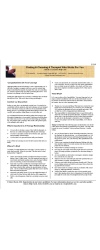Both Ends Exercise To Nail Down Meaning Of Specific Values
The techniques we are going to talk about is “Both Ends Against The Middle”. It can be used, and modified in group sessions to help people define what any particular value or set of espoused values means in terms of behavior and decision-making.
It can be used as a facilitated process as part of strategic planning to define corporate values, or it can be used as a less interactive process given by executives to help others understand the meaning of the corporate core values.
It is also an excellent exercise for self-exploration of one’s own value system, since the techniques forces you to think about your own values and beliefs as they relate to how you live your life (enact them).
How To Do Values Into Action Exercise
- Choose a particular espoused value
For example, you might have values about community involvement, customer service, honesty, integrity…. - Present a related scenario to test boundaries of the value.
For example, if the espoused “value” is excellent customer satisfaction”, here’s a scenario - A customer walks in with an item that was probably purchased from our store, but lacks a receipt. He wants a refund. Is providing the refund an acceptable way to demonstrate our commitment to excellent customer service? Do we do it knowing it means lost revenue or that the customer may be lying?
- The answer to this helps define the transition from espoused to enacted values.
- Choose another scenario where the possible action is probably what you don’t want.
- For example, in the same scenario as above, the representative could have told the customer to “F*** off, you lying scum”. Discuss this (hint it’s not not consistent with the value).
- You start from the extreme ends of desirable and undesirable behavior. Those are very easy to define. Then each scenario gets less and less clear as to its consistency with the value in question.
- Summarize:
Since it’s impossible to cover every possible scenario to nail things down absolutely, at some point, you need to say: - Ok. So this value means that we [state what we do in behavioral/scenario results] and that we don’t [state what we do NOT do].
Some Hints On Both Ends Against The Middle
I’ve outlined the bare bones of the technique, and lots of embellishments are possible. Here are a few things to consider.
- Always use this or some other technique to be sure that, during strategic planning, values are defined and nailed down. NEVER assume that those present, or those affected will develop a common understanding of the behavioral expectations stemming from the values, unless someone helps them create them.
- You’ll notice the title reflects how we do it. Start at one extreme. Decide whether it’s desirable and reflects the value. Move to the other end. Decide whether it’s undesirable and does NOT reflect the value.
- Move towards the middle (which is where the gray areas live).
- It can help to have a trained facilitator run this, provided he or she has some understanding of the business and its espoused values. An outsider will work better than an insider to provoke more free wheeling exploration of the value structure.
- Don’t be obsessive about the process. You’ll never get it exact. There will be a point where the gray areas are so close together that you won’t be able to get any kind of consensus from any group on whether they are congruent with espoused values.
- The process need not be interactive. For example, let’s say the executive draft a statement of values, and wish it to serve as guidance for every employee. The values can be “taught” to employees by using the scenario technique: Presenting what fits and does not fit the values.
- The same technique can be used for an individual to discover what it means to him or her to be “kind”, or “honest”, or “taking pride in one’s work”. Work from each end with possible real life scenarios.






